#vol xiii
Explore tagged Tumblr posts
Text
“CLOUD Vol.1″ (2007) translations Final Fantasy Agito XIII
p.76-77

hidden battle in the magic institute
Unhatched Elite Warriors The Guidance Myth
The mountains are green, the sky is blue. Your heart is rosy as you walk along the path.
Today is your first day as a student at the Akademeia peristylium. As you gaze at the gates of the magic academy shining brilliantly in the distance, your heart swells with thoughts of the events in your future. When you pass through those gates, you will meet new friends and discover new knowledge.
What sort of people are there? I don't want to be friends with anyone unpleasant. I wonder if it's really that hard to use powerful magic?
Such innocent thoughts are mixed in with the harsh questions you ask yourself.
How strong can I become? Can I become Agito?
The answers to all of the thoughts and questions dwelling in your heart exist beyond the gate. Akademeia's gate is also the gateway to infinite possibilities for you. Meeting good friends will nurture your heart, and discovering good knowledge will improve your skills.
No matter how difficult the ordeals ahead of you may be, why should you hesitate at these big gates!
You continue down the path, gazing at the towering school building with many thoughts inside of you, dreaming of the day when you become the legendary warrior known as Agito.
The Akademeia peristylium is the setting of FF Agito. The protagonist is a student who makes an oath with the Crystal which is enshrined within the academy. While living together with other students, they will study various things and receive training to accomplish their goals.
In a sense, school life is a series of discoveries. The protagonist grows as they learn not only what the instructors teach them, but what their friends are good at, the personalities hidden beneath their masks, and the power hidden within themselves.
What are friends? What is nature? What is magic? What is war?
The day will surely come when you will be able to answer the many questions you had in mind when you entered the academy.
On the other hand, your school life will be filled with many mysteries. What exactly is Agito, the legendary warrior? And who has their sights set on the academy's Crystal? Everything will become clear when the protagonist completes their studies at Akademeia and graduates. And then, that's when the protagonist's true fight will begin.
However, you mustn't forget. No matter how painful it is, no matter how hard it is to find your way, you are never alone. When you look back, the friends with whom you shared joys and sorrows will be there, along with the instructors who will guide you toward the right path.
Now is the time to pass through the gates with your head held high! Through Akademeia's gates! The entrance to a new mythical world!
p.78-79
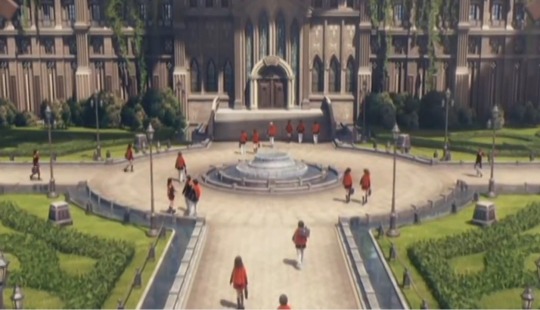
The True Colors of Akademeia to Which Youth is Entrusted
The academy that the protagonist enrolls at is officially known as "Akademeia, the Peristylium of Suzaku", located in a region called Rubrum. The students who enroll are sorted into 13 classes and are subject to strict discipline. They spend their days undergoing intense training. Knowing that the peristylium is a place for elite warriors, it is easy to imagine what sort of training they will receive.
In the process, friends may lose their lives. Some may not be able to endure the harsh training, and some may even run away. There will be scenes that leave you feeling empty, and scenes that will make you want to look away. However, all of these things are a part of life at the peristylium, and the protagonist and their friends must overcome it.
As you may know, "Suzaku" is the name of the Vermilion Bird, one of the four Chinese celestial beasts who rule over the cardinal directions. In that case, it's natural to assume that there are rivaling entities named after the Azure Dragon, White Tiger, and Black Tortoise. If each academy possesses their own Crystal, a push and pull might occur over them.
What does the aspirational name of "Agito" mean?
After enrolling, the goal of the protagonist is to become the legendary warrior called "Agito." That name, which is also used in the title, comes from a Latin word meaning "to put into motion." What kind of skills they use, what type of weapon they carry, how to become Agito... To new students, Agito is a very vague thing. However, as they spend time with many friends and teachers, it will be revealed little by little and gradually take shape.
As it inches closer to realization, Agito will become the goal and emotional support for not only the main character, but all of the other students as well.
It is said that one must overcome every hardship in order to become Agito. In that case, that movement of the heart would be the first step towards becoming Agito, the one who "puts things in motion." However, even if the protagonist overcomes the intense training, successfully graduates, and becomes Agito, that is not the final goal. Why are we fighting, and what is considered victory? And what will we learn in that battle?
The path that begins with enrollment at Akademeia is long and steep.
p.80-81
FF Mobile Online

Unlike the other two works, "FF Agito XIII" will be delivered straight to your hands through your cellphone. "FF Agito XIII" will be the first to introduce a new system: online party play for multiple users.
Players will start the game by choosing the protagonist from the 12 characters with weapons in the illustration. You can form a party with other people who have the game.
It's easy to imagine the fun and surprises that you will find online as you step into this myth for the new century. The characters who weren't chosen by the player will be involved in the story as NPCs, guiding the protagonist to an unknown world.
The advantage to mobile gaming is the ability to pick up the game and play it anywhere, at any time. In other words, the entrance to "the new story of the Crystals" is located right in your pocket.
EXPECTATION: A XIII Title That Begins in the Palm of Your Hand, FINAL FANTASY Agito XIII
1.
This FFXIII title will be played on mobile phones. Although spin-offs and other works have been ported to mobile, this will be the first official title to be released on mobile. As such, you can expect it to be a fresh Final Fantasy with possibilities previously unseen in the series. It's a Final Fantasy that's easy to enjoy anywhere, anytime. Through the network, it's also infinitely expandable. The appeal of being able to play with your friends as well as people you've never met... The appeal of a worldview with a magnificent scope via the distribution format... The appeal of network games that take advantage of "communication", which still have a high bar for entry, will be made accessible to many people with the use of cellphones, the easiest and most familiar platform.
The specs of mobile phones are also of interest, as they continue to evolve at a rate approaching that of handheld devices like the DS and even the PSP. Based on that evolution, "FF Agito XIII" is being produced with specs that look ahead to the future. This is the latest title in the series, following the Final Fantasy tradition of being on the cutting edge of the industry.

2.
As this title is being designed for the next generation of phones, its depth is still unmeasurable. The most appealing feature of the game is the fact that you can fight with parties that you form with other players, all from your phone. Players will be able to spend their time together as students of Akademeia, based on the magnificent ideas of the Final Fantasy series. That alone is cause for excitement.
The images that have been released show that the surrounding area is in a terrible state of ruin, so it will be interesting to find out how it relates to the story. Although it seems like the game won't be delivered regularly, the volume of the story is expected to be substantial. There will be many sub-events which can be voluntarily participated in and enjoyed for a long time. We're looking forward to the elements which will only be possible with next-gen mobile phones.
3.
People grow with more than lessons and training. During school, which everyone experiences at least once in their lives, the time after school when you've been released from your classes is important. When they're freed from the prison known as "school" and from the jailers known as "teachers", students learn a lot through activities with like-minded friends or through impulsive pranks. Without a doubt, "communication" is one of the most important elements of FF Agito XIII. "After school adventures" with allies you've never met can be fun and exciting, but they can also sometimes produce disappointments that you would have never felt when playing alone. However, there is a real story of player development that goes beyond the game character's development. Isn't that the true beauty of FF Agito XIII?
#final fantasy#fabula nova crystallis#final fantasy agito xiii#final fantasy type 0#translation#cloud vol 1
13 notes
·
View notes
Text

The Mementos Tweet For an Incredibly Niche Overlap of Audiences, Vol. XIII,
#strelsings#warrior cats#warriors#wc#rtvs#radio tv solutions#wayneradiotv#mementos memeposts#jesus it gets the#mementos hall of fame#tag already. and it's soon to get the 100+ tag too. christ#AND THERE IT IS#mementos monumentals#notifs muted; have fun folks 🫡
1K notes
·
View notes
Text
Wednesday April 19.
today, nearly 2,000 years ago, someone in pompeii baked bread.
Ahh, picture it. The time, around 2,000 years ago—the place, Pompeii. Simpler, happier times in some ways; and for the ruthless power games, insatiable sexual appetites, wild ambition, and creative genius, less so in others. However, following yesterday's foray into pastries, and all things fluffy, warm, and flakey, it dawned on us that this day around 2,000 years ago a happy chappy somewhere in the city's magnificent walls got to work and made some bread. CIL vol. IV 8972: XIII K. Maias panem feci—which translates as: On April 19th I made bread. And we love that for you, even millennia later! So, one day after our sweet celebration, it's time to pay homage to pastries' savory counterparts by marking April 19 with #bread. And a happy 2,000th anniversary to whichever miscellaneous Pompeian who decided not simply to make bread, but to mark the occasion with graffiti. But how do we know this? Well, it is thanks to the enquiring minds as evident in this post from @todayiwrotenothing, and indeed this commemoration on Reddit. Every day is a school day over here on The Internet.
Today it comes in countless forms, shapes, and sizes: wholewheat, rye, sourdough, multigrain bread, baguette, ciabatta, pumpernickel, soda, focaccia, cornbread, bagel, flatbread, naan, brioche, challah, and, last but by no means least, the ever-trusty white bread. As you will shortly see in the following string of bready content, this is simple yet limitless food: it can be braided, made by illustrated cats, or indeed constructed in the shape of the dashboard's beloved, hapless vessel, the good ship Ever Given.
So here's to you, as-yet-unnamed Pompeian who not only makes the bread, but brags about it too. We think you would have enjoyed this one-day tribute to your escapades here with #bread. We shall submit a formal application to rename it Tumbread, in your honor. But that's still not all: rumor has it there is sister graffiti that reads "Olivia condita XVII Kalendas Novembres"—so come back on November 16th for preserved olives.
#today on tumblr#pompeii#bread#yum#graffiti#bread time#sourdough#bready#steady#go#yeast#staple foods
6K notes
·
View notes
Text

L'Art et la mode, no. 49, vol. 15, 8 décembre 1894, Paris. Toilettes d'hiver. Dessin de G. de Billy. Bibliothèque nationale de France
Toquet de velours miroir turquoise drapé et noué devant avec un coulant de vieux strass. Grand nœud de satin noir sur la calotte. Plumes et crosse noires fixées de côté en panache. Touffes de violettes de Parme au-dessus des oreilles.
Turquoise mirror velvet toquet draped and tied in front with a flow of old rhinestones. Large black satin bow on the crown. Black feathers and crosier fixed on the side in a plume. Tufts of Parma violets above the ears.
—
Robe en drap vanille. Blouse flottante en breitschwantz serrée à la taille par une ceinture de velours pensée à boucle de vieil argent. Revers coquilles pareils sur le haut des manches. Collier de velours pensée.
Dress in vanilla cloth. Floating blouse in breitschwantz tightened at the waist by a velvet belt with an old silver buckle. Similar shell lapels on the upper sleeves. Velvet collar.
—
Robe en velours crocodile bleu de France, garnie de renard bleu. Manches de drap blanc ornées d’appliques de velours bleu. Manchon de renard bleu.
Dress in blue crocodile velvet from France, trimmed with blue fox. Sleeves in white cloth decorated with blue velvet appliques. Sleeve in blue fox.
—
Robe en velvetine châtaigne perforée sur transparent de satin bleu lavande, garnie dans le bas a’une petite ruche en velours découpé. Corsage découpé en bandes à la taille s’ouvrant sur un coulissé de satin lavande. Col de zibeline avec queues, fixé sur les épaules par deux touffes de pavots.
Dress in perforated chestnut velvet on transparent lavender blue satin, trimmed at the bottom with a small ruffle in cut velvet. Bodice cut into bands at the waist opening onto a lavender satin drawstring. Sable collar with tails, fixed on the shoulders by two tufts of poppies.
—
Robe en drap satin banane, ourlée de vison. Veste Louis XIII en velours miroir feuille morte. Gilet de moire crème orné d’un volant de point d'Angleterre. Chapeau feutre avec boucle ancienne et panache de plumes.
Dress in banana satin cloth, hemmed with mink. Louis XIII jacket in dead leaf mirror velvet. Cream moire waistcoat decorated with a point d'Angleterre flounce. Felt hat with antique buckle and feather plume.
#L'Art et la mode#19th century#1890s#1894#on this day#December 8#periodical#fashion#fashion plate#description#bibliothèque nationale de france#dress#corsage#hat#gigot#Modèles de chez#G. de Billy
88 notes
·
View notes
Text

The Nursery: A Monthly Magazine for the Youngest Reader - Vol. XIII - 1873
32 notes
·
View notes
Text
𝔟𝔩𝔞𝔠𝔨 𝔠𝔞𝔱 𝑔𝑜𝓁𝒹𝑒𝓃 𝓇𝑒𝓉𝓇𝒾𝑒𝓋𝑒𝓇 | series masterlist
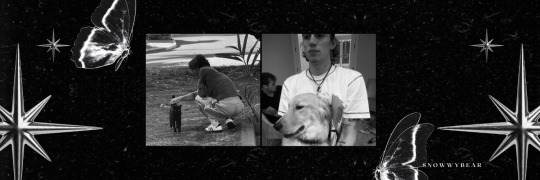
A collection of shorts about golden retriever Vinnie hacker and his black cat girlfriend.
All shorts contain no warnings
vol i | meeting ✨
vol ii | getting used to the love ✨
vol iii | date nights ✨
vol iv | staring contest ✨
vol v | understanding him ✨
vol vi | understanding her ✨
vol vii | conflict resolution ✨
vol viii | realising your in love ✨
vol ix | bullying flirting ✨
vol x | going out together ✨
vol xi | just because - requested by anon ✨
vol xii | if looks could kill - requested by anon ✨
vol xiii | no because i'm panicking - requested by anon ✨
vol xiv | convince me - requested by anon
vol xv | coming soon- requested by anon
Specials vol i | roles reversed
#vinnie hacker#vinnie hacker x reader#vinnie hacker imagine#vinnie hacker smut#vinnie hacker x you#vinnie imagines#vinnie smut#vinnie x reader#vinnie x y/n#snowwybear
265 notes
·
View notes
Text
All Greyche Drama Art Pieces (from 2024)
Thank you for your support and for hyping me to create such pieces Let's start... with the beginning: 1 & 2.


3. "The Dance"

4. Inspired by vol 36

5. "The Lovers"


6. "Once Upon a Time..."

7. "Purple"

8. "The Judgement"



9. "Death XIII"

10. "The Devil"

11. "Before the Judgement"

12. "The Tower"

13. "Justice"

14. "Flower in the mirror"

15. "Love shot"

and that's it overall :)

any fav?
#fan art#black clover#black clover fanart#black clover art#gauche adlai#grey black clover#digital art#gauche x grey#grey x gauche#greyche#greyche drama#dramatic art#romeo and juliet#bc spoilers#ブラッククローバー#ゴシュグレ#jaycrakhead#gauche adlai art#gauche black clover#black clover gauche#black clover grey#ship art#art summary 2024
26 notes
·
View notes
Text
Wave Race 64 | Kazumi Totaka - Podium: 4th Place (From Nintendo Sound Selection Vol. 1: Healing Music) Pizzicato Five | Let's Go Away For a While (Concert Arrangements)
Hi everyone, I just finished my nostalgic frutiger/y2k mix, Dolphin Bedroom! ^_^ Please sign the guestbook on YouTube!! (^^;)
(Hey You, Pikachu!) Miki Obata - Good Night!
(Sonic CD) Naofumi Hataya, Masafumi Ogata - Quartz Quadrant “G” Mix (JP)
(NiGHTS Into Dreams) Tomoko Sasaki & SEGA Sound Team - Dreams Dreams ~In Silent Memory~
(Phantasy Star Online) Hideaki Kobayashi, Fumie Kumatani - Title
(We ♥ Katamari) Karie Kahimi, Tomoki Kanda - Blue Orb
(Wave Race 64) Kazumi Totaka - Podium: 4th Place (From Nintendo Sound Selection Vol. 1: Healing Music)
Pizzicato Five - Let’s Go Away For A While (Concert Arrangements)
(Wave Race: Blue Storm) Lawrence Schwedler, James Phillipsen - Aspen Lake REPLAY
(NiGHTS Into Dreams) Tomoko Sasaki & SEGA Sound Team - After the Dream
Serani Poji - mune-aki (Instrumental)
(Final Fantasy XIII) Masashi Hamauzu - Sunleth Waterscape (Instrumental)
(Pokémon Legends: Arceus) Go Ichinose, Hitomi Sato, Hiromitsu Maeba - Cobalt Coastlands 2 (Alt. Version)
(Super Smash Bros Ultimate) Asuka Ito - Pedal Glider
(Chrono Cross) Yasunori Mitsuda - Sailing (Another World)
(Wii Photo Channel) Kazumi Totaka - Scenic
(Sonic CD) Naofumi Hataya, Masafumi Ogata - Collision Chaos “G” Mix (JP) (Final Fantasy X) Nobuo Uematsu, Masashi Hamauzu, Junya Nakano - Illusion
Lone - AM Portal
Fantastic Plastic Machine - Mr. Fantasy’s Love
(Sonic Adventure) Jun Senoue, Kenichi Tokoi, Fumie Kumatani - Join Us 4 Happy Time …for CHAO Race
(Katamari Forever) Rei Harakami - Do-re-mi Katamari Do (-rh rehabilitation re-arrange-)
(Ico) Michiru Ōshima - Heal
(The Legend of Zelda: Ocarina of Time) Koji Kondo/MOKA - Great Fairy's Fountain (From The Legend of Zelda: Ocarina of Time Re-Arranged Album)
36 notes
·
View notes
Text
ARTICLES AND BOOKS (and illustrations!) BY H. GOODSIR
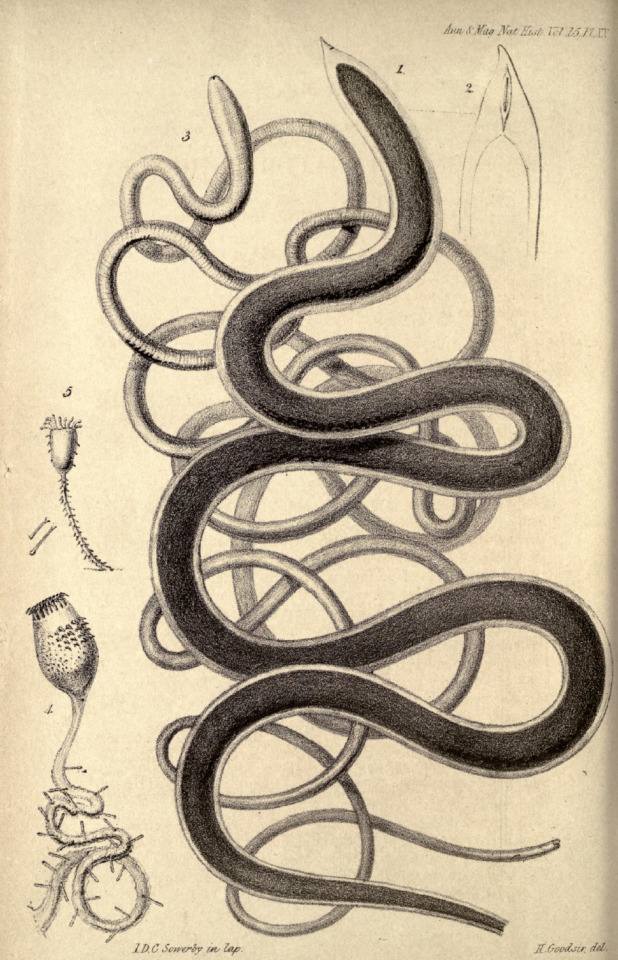
BOOKS
- Anatomical and pathological observations, 1845.
Goodsir, John (1814-1867) Goodsir, Henry Duncan Spens ("Harry") (1819-1847).
Link: https://www.biodiversitylibrary.org/item/75603#page/9/mode/1up
Harry is the author of the following three chapters:
N°VI. The testis and its secretion in the decapodous crustaceans (pp 35-40)
N°XII. The mode of reproduction of the lost parts in the crustacea (pp 74-78)
N°XIII. Of the anatomy and development of the cystic entozoa (pp 79-103)
> The last one was read before the York Meeting of the British Association in 1844. I did a little research and found that Goodsir was “secretary” in the zoology and botany section:
(Read more:https://www.ypsyork.org/resources/articles/the-1844-british-association-conference-and-the-first-photographs-taken-in-york/ )
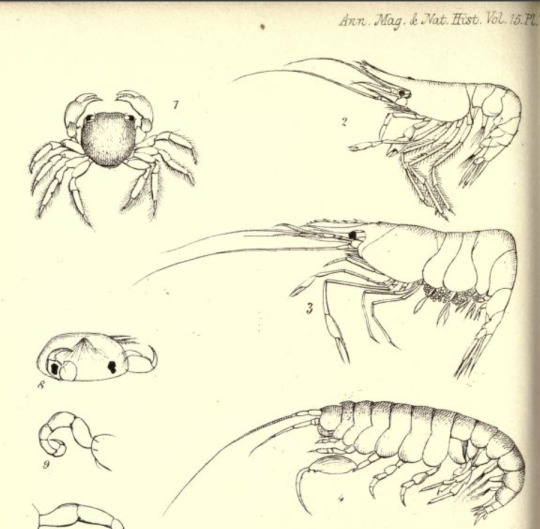
-Cases and observations illustrating the history and pathological relations of two kinds of hydatids, hitherto undescribed, 1844
Goodsir, Harry D. S. , Gairdner, John, Lee Thomas M. , Royal College of Physicians of Edinburgh
Link: https://www.biodiversitylibrary.org/item/180385#page/3/mode/1up
Microscopial observations (two pages of illustrations at the end of the book, low quality).

-On two new species of leachia, 1841
Goodsir, Henry D. S. Esq.
(from the Edimburgh New philosophical Journal for October 1841)
Link: https://www.biodiversitylibrary.org/item/188531#page/1/mode/1up
(One illustration at the end)
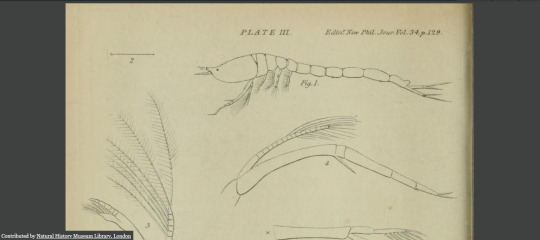
ARTICLES
-Description of the genus Cuma, and of two new genera nearly allied to it, 1843
in: The Edinburgh new philosophical journal, vol. 34, pp 119-129
Link: https://www.biodiversitylibrary.org/page/12565428#page/139/mode/1up
(Illustrations at the end)

-On the specific and generic characters of the araneiform crustacea, 1844
in: The Annals and magazine of natural history; zoology, botany and geology, vol. 14, pp 1-4
Link: https://www.biodiversitylibrary.org/page/2331360#page/14/mode/1up
(One plate at the beginning)
- Description of some animals found amongst the Gulf-weed, february 1845
in: The Annals and magazine of natural history; zoology, botany and geology, vol. 15, pp 73-76
Link: https://www.biodiversitylibrary.org/page/2248314#page/98/mode/1up
(One plate at the beginning)
- Description of some gigantic forms of invertebrate animals from the coast of Scotland, june 1845
in: The Annals and magazine of natural history; zoology, botany and geology, vol. 15, pp 377-383
Link: https://www.biodiversitylibrary.org/page/2248663#page/427/mode/1up
(One plate at the beginning)

-On the development, structure and eoconomy of the acephalocysts of authors; with an account of the natural analogies of the entozoa in general, june 1845
in: The Annals and magazine of natural history; zoology, botany and geology, vol. 14, pp 481-484
Link: https://www.biodiversitylibrary.org/page/22068990#page/495/mode/1up
Abstracted from the Transactions of the Royal Society of Edinburgh, having been read April 1, 1844.
> which I, of course, found:
Transactions of the Royal Society of Edinburgh, vol XV
pp. 560-571, three plates
Link: https://archive.org/details/transactionsofro15roya/page/560/mode/2up?view=theater
(His brother was also there!)

-On several new species of Crustaceans allied to Saphirina, 1845
in: The Annals and magazine of natural history; zoology, botany and geology, vol. 16, pp 325-327
Link: https://www.biodiversitylibrary.org/page/22069398#page/339/mode/1up
+Plate XI (at the end)
This last article is also mentionning the Erebus... I'm not crying, you are.
PS: I hope you enjoyed this overview of Goodsir's work, it took me days to gather it all and I'm glad to be able to share it with you all. As I'll soon be in Edinburgh, you can expect to see more Goodsir content! Love <3
100 notes
·
View notes
Note
hi!! would you be open to sharing some of your experiences with worshipping the kharites? how have they impacted your life? i'm interested but there's so little information surrounding them. thank you so much :D
Ah hell yeah! I'll jump on any chance to talk about them!

I love the elder Kharites so much, sure I honor ALL of them but the first three are the ones directly in my life, and the third to have a statue on my altar. My main go-to with them is every art that has to do with writing, those that really eat up poetry and storytelling in all forms. They're givers of joy, grace, beauty, and eloquence, and the ones I lean on most for my own writing more than anyone else in company with two that they're in the retinue (staunch companions) of Hermes and Aphrodite. I feel like I might be the odd one out on my tendency to lean on them with H and A over the Mousai and Apollon, but it's just what feels most right for me. I can't dream of it being the latter when in my mind the five in question embody what grips and makes writing special while also being patrons of the arts.
To put it into perspective and why I went from honoring, to actively worshipping and now being their devotee and crediting them with every piece I make:
Bacchylides, Fragment 10 (trans. Campbell, Vol. Greek Lyric IV) (C5th B.C.) : "Truly the skilled man [poet or artisan] prospers in golden hope, whether he has won honour from the Kharites (Charites, Graces)."
Pindar, Nemean Ode 4. 6 ff (trans. Conway) (Greek lyric C5th B.C.) : "If that man with the Kharites' (Charites', Graces') favour haply bring forth the heart's deep mood to live upon the tongue."
Pindar, Olympian Ode 14. 1 ff (trans. Conway) (Greek lyric C5th B.C.) : "Whose haunts are by Kephissos' (Cephisus') river, you queens beloved of poets' song, ruling Orkhomenos (Orchomenus), that sunlit city and land of lovely steeds, watch and ward of the ancient Minyan race, hear now my prayer, you Kharites (Charites, Graces) three. For in your gift are all our mortal joys, and every sweet thing, be it wisdom, beauty, or glory, that makes rich the soul of man. Nor even can the immortal gods order at their behest the dance and festals, lacking the Kharites' aid"
From their theoi page: "The character and nature of the Charites are sufficiently expressed by the names they bear: they were conceived as the goddesses who gave festive joy and enhanced the enjoyments of life by refinement and gentleness. Gracefulness and beauty in social intercourse are therefore attributed to them. (Horat. Carm. iii. 21, 22; Pind. Ol. xiv. 7, &c.) They are mostly described as being in the service or attendance of other divinities, as real joy exists only in circles where the individual gives up his own self and makes it his main object to afford pleasure to others. The less beauty is ambitious to rule, the greater is its victory; and the less homage it demands, the more freely is it paid. These seen to be the ideas embodied in the Charites. They lend their grace and beauty to everything that delights and elevates gods and men. This notion was probably the cause of Charis being called the wife of Hephaestus, the divine artist. The most perfect works of art are thus called the works of the Charites, and the greatest artists are their favourites. The gentleness and gracefulness which they impart to man's ordinary pleasures are expressed by their moderating the exciting influence of wine (Hor. Carm. iii. 19. 15; Pind. Ol. xiii. 18), and by their accompanying Aphrodite and Eros. (Hom. Od. viii. 364, xviii. 194; Paus. vi. 24. § 5.) They also assist Hermes and Peitho to give grace to eloquence and persuasion (Hesiod. Op. 63), and wisdom itself receives its charms from them. Poetry, however, is the art which is especially favoured by them, whence they are called erasimolpoi or philêsimolpoi. For the same reason they are the friends of the Muses, with whom they live together in Olympus. (Hes. Theog. 64; Eurip. Herc. fur. 673; Theocrit. xvi. in fin.) Poets are inspired by the Muses, but the application of their songs to the embellishment of life and the festivals of the gods are the work of the Charites."
It certainly doesn't help that so many of the gods I focus on and are most important to my personal worship directly have them in their retinue or are their companions in the sense like the Mousai and the Horai where it's more an equal footing kind of thing versus what it's like with Hermes, Aphrodite, Apollon, Athene, Artemis, Dionysos, Hera, Hekate, and while it isn't noted anywhere, I can't see it in any other way than Hestia's inclusion as one of the trio leaders of festivities with Hermes and Dionysos and the Kharites embodying mirth, cheer/excitement, and festivities.
The best way to devote yourself to them and my go-to when I'm down and don't have the energy or focus and willpower to do much more is to do something for myself that will bring joy, comfort, and elation in their name. Hedonism and doing your hobbies go a long way with them.
Further reading:
The Graces in Ancient Greek Mythology
The Graces by Louis de Jaucourt
The three Graces, or the allegory of the gift published by Denis Vidal (also here if the other link dies)
Pausanias tries to visualize the three ‘Graces’ of Orkhomenos in Boeotia by Gregory Nagy
The Three Graces: Cosmic Harmony in Scève's Délie by Joan A. Buhlmann
The Three Graces: Composition and Meaning in a Roman Context by Jane Francis
#asks#dorian's polytheism diary#hellenic polytheism#hellenic paganism#hellenic gods#hellenic deities#hellenic worship#the graces#kharites#the kharites#the charites#when I'm feeling it I plan on making an epithets list for them#love them#they are genuinely fantastic
29 notes
·
View notes
Text
“CLOUD Vol.1″ (2007) translations Final Fantasy Versus XIII
p.68-69

there is basically no right or wrong in things
Promises Crumbling Away The Colorless Myth
All games are built upon the "promises" made between the players and creators. The more well-known a title becomes, the stronger it becomes. To put it another way, the more "promises" people feel comfortable with, the easier it is for them to play the game with peace of mind.
So, when speaking of games - particularly RPGs - what are those "promises"? That there will be good and evil? Friends and enemies? That it goes without saying that the protagonist, who represents you, is good? Even if you save the world, the world won't save you... Now, does it become easier to understand if we put it this way?
There is no Final Fantasy without a happy ending.
Up to this point, these things have been considered absolute truths. This is because, no matter how innovative Final Fantasy is each time, they're titles that many people want to play (that we wanted them to play) comfortably with peace of mind. No one thought of escaping from that fate. Until that time...
At the 2006 E3 conference and in the interviews shortly thereafter, Kitase and Nomura said this: "FF Versus XIII is a truly sad story that feels like a tragedy." "It would be risky to call it Final Fantasy by itself, so we wish to express things that couldn't be done with numbered titles." The bold decision to release three works simultaneously. By launching at the same time as "FFXIII", the legitimate numbered title successor, another unprecedented Final Fantasy will begin while escaping the fated promises. Is it too much to think that this series of events was an ingenious plot to bring "FF Versus XIII" into the world?
Now, what does "FF Versus XIII", which is a Final Fantasy freed from promises, want to express?
The hint can be found in this verse from Shakespeare, which is quoted in the "FF Versus XIII" video: "There is nothing either good or bad, but thinking makes it so."
Indeed, these words mean liberation from promises which will shake players' preconceptions to the core. Is the protagonist good? And does good mean right? The foundation of each promise that was considered safe in the game will collapse, and a dazzling unknown impact will strike the player.
Colorless myth - that is, a myth that begins from zero in a world where common sense doesn't exist. It could be said that this is a story where the colors arrive according to the way we feel.
---
Translator’s note: After reading this, I can’t help but say “Please play Final Fantasy Type-0.”
#final fantasy#final fantasy versus xiii#final fantasy xv#verum rex#fabula nova crystallis#cloud vol 1
12 notes
·
View notes
Text
Some Anne-ouncements Following Reignited Book I

In just a few moments, I'll be releasing Home, the final chapter of Phoenix Reignited Book I: Ashes. The end of a book is usually a great time to make some Anne-ouncements, and so, without further ado...
Phoenix Reignited Book II: Embers

There will be no gap between book postings for Reignited; this coming Tuesday you will see chapter one of Phoenix (re)Ignited Book II: Embers. The new book will continue in the existing work on AO3 and all the other platforms, so folks who are subscribed / following / whatever it's called on your platform of choice will continue to get alerts.
Reignited on Royal Road
We're finally ready to announce the release schedule for Royal Road! I've wanted Reignited on Royal Road for some time, but held off due to the unforgiving nature of their Rising Stars algorithm that all but requires posting chapters with a certain cadence I could not meet until I had built up some backlog.
Reignited will launch on Royal Road December 1, 2024, with ten chapters dropping on that day. It will then receive a chapter drop every day for the next thirty days, and as such, on December 31, 2024, Royal Road will "catch up" with the other platforms that have been getting updates all along. Beginning on January 2, 2025, Royal Road's Reignited release schedule will fall back to Tuesday/Thursday/Saturday alongside the other platforms.
Folks wishing to support the story's success on Royal Road can help by reading the new drops on the platform daily as they are released, and leaving advanced reviews. These things dramatically increase the story's ranking in the algorithm, especially in the early going.
A Reignited Reorganization on Wattpad
I had announced that all the platforms would get Reignited as one huge work, rather than breaking it up by book as I did with the original series on AO3 or by series as I did on Wattpad, QuoteV, Royal Road and Scribble Hub.
Unfortunately, I've learned that Wattpad has a 200-chapter maximum for a work, which means a Reignited series through book XIII would actually need three volumes to get through it. Rather than doing a Vol. 1, Vol. 2 which end at arbitrary places in the story when the 200th and 400th chapter is reached, I've decided to go ahead and just do it by series on Wattpad like I did the original. So, there will be a Phoenix Ignited: Reignited Edition, followed by a Phoenix Ascendant: Reignited Edition and Phoenix Odyssey: Reignited Edition. Sorry about the confusion.
Sunsetting Reignited on MediaMiner
I was - and remain - excited whenever I discover a new platform to expose Phoenix to, and when I found MediaMiner (which apparently came and largely went during my hiatus from the world of fandom) I immediately sought to post Phoenix there.
However, as I've now gotten through 24 chapters there, I'm noticing lots of problems. The interface is old and largely broken, leading to a convoluted solution where the only way to properly format even basic things like italics is to make a specially-formatted RTF file. It takes almost four times as long to post a chapter to MediaMiner as to any of the other 11 platforms Reignited is currently on. Additionally, all of the algorithmic things like trending lists are entirely broken; the top trending story on MediaMiner has not been updated since 2009.
These things I could have dealt with, but the dealbreaker for me is interaction notifications. When people comment on a chapter, I get no notification. There's no inbox, no emails, nothing; I have to literally click on every chapter and scroll to the bottom to see if there's comments waiting for me. I find it entirely unacceptable that people could comment on my work and not get an acknowledgement from me, and short of spending a half an hour checking, I have no way whatsoever to know if it's happened.
For this reason, I've decided to suspend posting to MediaMiner after this chapter. I'll add a "25th chapter" essentially explaining this decision and linking to the various and sundry other platforms on which Reignited will continue, and leave Book I on the platform as essentially a glorified trailer for the larger work.
I don't know if anyone is reading on MediaMiner - I have no way whatsoever to tell - and if someone is and this causes you great distress, please tell me. I'd be willing to reconsider if it's actually helping anybody to post there, but right now it seems to be all pain, and no benefit to anyone.
Book XIII progress
As I mentioned Thursday, I'm taking a brief (1-2 week) pause on Book XIII to focus on Reignited Book II and getting some "life stuff" dealt with. I have a bunch of time off from work over the next two weeks and expect to really be able to throw myself into this and make some good progress.
Open Invitation: The Storytellers' Speakeasy

As I've mentioned before, the inestimable @princesscolumbia and I have merged our fan Discord servers to create the Storytellers' Speakeasy, a community for fans and fandoms to converge. I'm shocked and pleased to report that in under two months, we've reached about 90 friends in our little group, including more than fifteen fellow Storytellers who share and collaborate on their own fanworks and original stories with us.
(Haunted Mansion voice) But, there's room for a thousand...
Whether you're a Storyteller in your own right, or just want to hang with us, see previews, beta read, kick it in a supportive community, and maybe - just maybe - hear me humiliate myself and sing Ranko's songs live on stream from time to time, we invite you to join our community.
The Speakeasy is a safe and supportive environment for all people, including and especially LGBTQIA+ folks of all stripes, and a sex-positive space. All NSFW content is separately moderated and hidden behind an opt-in role. We have active fandom discussions for Ranma 1/2, My Little Pony, Star Trek, Pokemon, Sailor Moon and several others, plus channels for gaming, writer support, trans/gender stuff, and more. We'd love to see you around the Speakeasy!
So that's it!
Thank you all so much for your time, attention and support. Reignited has been doing so much better than I could have hoped or dreamed, and it's thanks to each and every one of you.
From the bottom of my heart,

#fanfiction#ranma fanfiction#ranma 1/2#ranma#girl ranma#phoenix reignited#fanfic#ao3 fanfic#ao3#ao3 writer#ao3fic#fanfic writing
15 notes
·
View notes
Text

Le Petit écho de la mode, no. 29, vol. 17, 21 juillet 1895, Paris. 2. Grands cols lingerie. Ville de Paris / Bibliothèque Forney
(2.) Grands cols lingerie. — La mode dédaigne totalement ces cols en guipure style Louis XIII. Les voici remplacés par les grands cols Louis XIV en linon brodé qui empruntent à l’imprévu leurs plus hardis caprices et dessinent poétiquement le cou et les épaules. Cet harmonieux encadrement rend la tête si fraîche, si fine, si jolie que les grandes mondaines l’adaptent â leurs chemises de nuit. C’est la variété du goût aristocratique dans sa plus originale expression que les créations en ce genre de la maison Jeanne d’Arc. Les Parisiennes raffinées et les riches étrangères accueillent ces types inédits, d’une si exquise distinction, comme une inspiration de leur renom d’élégance. Les prix établis pour ces grands cols sont les suivants: 10fr.50, 12fr.50, 15fr.50, 20 francs, 25 francs et 30 francs. Le nouvel album créé par Mme Desbruères est mis à la disposition de toutes nos lectrices; il suffit d’en faire la demande. Ce catalogue donne tous les prix des corsets avec buse ou sans buse, lingerie, trousseaux, jupons de soie, ainsi que la manière de prendre soi-même les mesures. Il suffit d’écrire à la Maison Jeanne d’Arc, 265 rue Saint-Honoré, Paris.
(2.) Large lingerie collars. — Fashion totally disdains these Louis XIII style guipure collars. Here they are replaced by the large Louis XIV collars in embroidered lawn which borrow their boldest whims from the unexpected and poetically outline the neck and shoulders. This harmonious framing makes the head so fresh, so fine, so pretty that great socialites adapt it to their nightgowns. It is the variety of aristocratic taste in its most original expression that the creations of this kind from the house of Jeanne d’Arc. Refined Parisians and wealthy foreigners welcome these unique types, of such exquisite distinction, as an inspiration for their reputation for elegance. The prices established for these large passes are as follows: 10.50 francs, 12.50 francs, 15.50 francs, 20 francs, 25 francs and 30 francs. The new album created by Ms. Desbruères is made available to all our readers; you just need to request it. This catalog gives all the prices of corsets with or without a busk, lingerie, trousseaux, silk petticoats, as well as how to take your own measurements. Just write to Maison Jeanne d’Arc, 265 rue Saint-Honoré, Paris.
#Le Petit écho de la mode#19th century#1890s#1895#on this day#July 21#periodical#fashion#fashion plate#description#Forney#dress#collar#Modèles de chez#Maison Jeanne d'Arc#Maison Desbruères
131 notes
·
View notes
Text






























Mahoraga 's Power 3 : Sukuna Vs Mahoraga XIII
Jujutsu Kaisen S2 [BD Vol.6] EP17 part 16
EP17 1/ 2/ 3/ 4/ 5/ 6/ 7/ 8 /9 /10/11 /12/ 13 /14 /15 /16 /17 /18 /19 /20 /21 /22 /23 /24 /25 /26 /27 /28 /29 /30 /31
Jujutsu Kaisen Blu-ray Disc Recap [All LINKS]
OP1 // OP2:: ED1 // ED2 /COVER
EP1 : EP2 : EP3 : EP4 ; EP5 : EP8 : EP9 : EP12 : EP13
EP14 : EP15 : EP16 : EP17
Feral Gojo : Sukuna Gifs
#Jujutsu Kaisen S2#anime#anime recap#anime cap#jujutsu kaisen#jjk#jujutsu#jjk s2#jujutsu kaisen season 2#jjk anime#jjk bd#jjk pic#jjk recap#sukuna#sukuna vs mahoraga#ryomen sukuna#sukuna ryomen#jjk sukuna#sukuna jjk#mahoraga#jjk mahoraga#makora
21 notes
·
View notes
Text

A Conspicuous Consumption* Christmas
* Tuberculosis
The Nursery: A Monthly Magazine for the Youngest Reader - Vol. XIII - 1873
#1873#vintage illustration#illustration#19th century illustration#christmas#xmas#family#christmas tree#funny#humor#humour
23 notes
·
View notes
Text
LITG S10 VOL XIII
So it wasn’t the worst, wasn’t the best, which is on par for this season. Here’s some highlights:
I’m actually surprised we met up with our OG LI. Seems like a missed opportunity again for a big reveal of MC returning at Stick or Twist. But that’s on brand for fb 🙃
Dean can get in the bin. I’ll smash the pay button to sass him. Every 👏 Time 👏
Who goes skinny dipping and leaves their bathing suits lying around? My guess is that Nyah was in the pool, but Isadora was in the shower. Yeah, those b*tches are dumb 💀
Yes, I went all the way with Yash. Sorry, Hayden. Movie night is gonna be messy 🍿
Enter the new “villain” Ava. Hands off Yash, please. Eisha is so pretty, though. And seems interested for wlw players 💕
Dumping next week? Is it too much to ask to for Ava to be Blake 2.0 and get dumped? 😂
11 notes
·
View notes